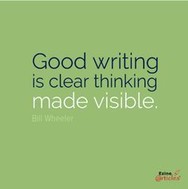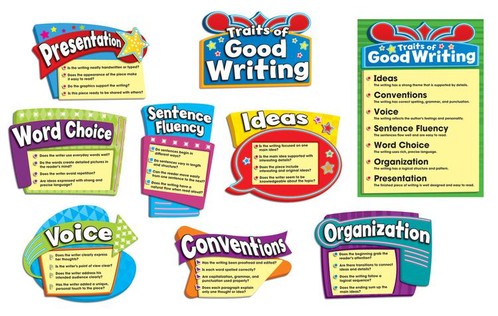How To Make Your Writing Flow - The Grammar-Us Blog - Grammar-Us
Main menu:
How To Make Your Writing Flow
 If you have been reading my blog posts for the past few weeks, you have gotten some tips and tricks about how to make your communications more effective through proofreading, editing, and “tightening up” your writing. This week, I would like to offer a few suggestions on how to make your writing “flow.” When you do this, your writing is not only more appealing, but also more easily read, and most importantly, more easily UNDERSTOOD by your audience.
If you have been reading my blog posts for the past few weeks, you have gotten some tips and tricks about how to make your communications more effective through proofreading, editing, and “tightening up” your writing. This week, I would like to offer a few suggestions on how to make your writing “flow.” When you do this, your writing is not only more appealing, but also more easily read, and most importantly, more easily UNDERSTOOD by your audience.
Once again, a key tool for writing that flows is the OUTLINE. When you have committed the skeleton of your project to an outline that sets out the main ideas you want to share, you already have a start toward a good “flow” to the final project. As I explained in previous blog posts, the outline does not have to be anything formal; even a bulleted list of your points is enough. You can then play with those points, rearranging them into a logical sequence, rejecting those that might not be quite “on point” – or relevant – to the overall premise you want to communicate.
Beyond the outline, here are some other tips to keep in mind when improving the flow of your writing:
1. HAVE A BEGINNING, A MIDDLE AND AN END. A professor once told me, “In good writing, you tell them what you’re going to say, say it, and then tell them what you just said.” In other words, give your work an introduction, a body, and a conclusion. This can be done in all forms of writing, from business letters to book manuscripts.
For example, a business letter might begin like this:
This letter is regarding our telephone conversation of November 14, 2014, in which we discussed specifications for the repair of my fence. I would like to take a moment to confirm the details we discussed.
You would then proceed with setting out the details. The letter could be concluded as follows:
Thank you again for taking the time to speak with me. I will be contacting you again soon to let you know if your bid has been accepted. Meanwhile, if you have any corrections or additions to the foregoing, please do not hesitate to let me know.
2. HOW TO DIVIDE YOUR PROJECT INTO PARAGRAPHS. If you have created an outline before beginning the actual writing of your project, the points you have listed will often suggest where paragraphs should begin and end. On the most basic level, one paragraph per point might be logical. If the points are more complicated and require longer explanations, you may need more than one paragraph to explain each one.
Conversely, it is usually NOT a good idea to have a paragraph consisting of only one sentence. There are exceptions to this, especially if you want to emphasize a specific point by setting it apart from the rest of the text. Use this technique sparingly, however. If a point is worth communicating, it probably merits more than just a single sentence; therefore, your paragraphs will likely contain more than one sentence.
The primary thing to keep in mind is to limit the paragraphs to ONE idea or point. When you try to cram too much information into just one paragraph, even the appearance on the typewritten page can be intimidating. White space on a page is much more inviting to a reader than a page that is “wall-
3. USE TRANSITIONAL WORDS. Whenever possible, try using transitional words to introduce your next paragraph. For example, see how I began the second paragraph in point #2 above. The word “conversely” can be considered transitional. It gives you a clue that what you are about to read relates to the preceding point, but it introduces another (in the case, the opposite) aspect. Other transitional words are “therefore,” “moreover,” “furthermore,” and “however.” There are others, with which you will want to familiarize yourself.
It is not always possible to use a transitional word. However, when you can, it will help to tie the paragraphs together and result in a less “jerky” or disjointed impression of what you have written. If transitional words really do not seem effective or advisable in your particular project, you might try using bullet points or numbered paragraphs instead, to tie the paragraphs together in some coherent way. If all else fails, take another, hard look at the paragraph and determine if it is even necessary! It could be that, if you are having difficulty making it “fit” into your project, it does not belong there at all. This could be an opportunity for your to “tighten up” your writing (see last week’s blog post) by deleting irrelevant material. When you have thoughtfully planned your communication, edited and proofread it, tightened up the writing and made it “flow,” you have given yourself the best possible chance of having your project read, understood, and perhaps even recommended to others! It may seem like a lot of work to polish your project in this way, but if it’s worth communicating, it’s worth doing right!
When you have thoughtfully planned your communication, edited and proofread it, tightened up the writing and made it “flow,” you have given yourself the best possible chance of having your project read, understood, and perhaps even recommended to others! It may seem like a lot of work to polish your project in this way, but if it’s worth communicating, it’s worth doing right!
- FRESH WRITING
- TWELVE ERRORS THAT MAKE A GRAMMARIAN GNASH HER TEETH
- THE WHYS AND HOWS OF WRITING AN EFFECTIVE CONSUMER LETTER
- FILLER WORDS: THE "JUNK FOOD" OF COMMUNICATIONS
- Pardon Me, Your Participle is Dangling!
- MAKE BETTER GRAMMAR A NEW YEAR’S RESOLUTION
- The Value Of Personal Letters
- How To Make Your Writing Flow
- How (And Why) To Tighten Up Your Writing
- Why Grammar Matters
- Time For Another Grammar Quiz!
- Editing: The "Make Or Break" Skill
- Proofreading: It Matters More Than You Think!
- Please Don't Ruin A Perfectly Good Tense!
- A Brave New Word
- Homophones: The Sequel
- Coulda, Shoulda, Woulda And Other Incorrectly Written Words
- More Homophones
- Time For Another Grammar Goof Quiz
- A Different Kind Of Colonoscopy (And Semi-Colonoscopy)
- Comparatives & Superlatives: The Good, The Bad, And The Ugly
- Either/Or, Neither/Nor: Decisions, Decisions!
- Let's Agree To Agree
- Avoiding Apostrophe Apocolypse
- Let's Pause To Honor The Comma!
- Three Speech Patterns That Can Compromise Professionalism
- A Hit Parade of Grammar Misses
- Negative Nancy Has Hijacked My Blog!
- Who Dat?
- Avoiding the Ill Effects of Misusing "Affect"
- How To Perfectly Use Six Irregular Verbs
- Random Ramblings
- Me, Myself and I: The Narcissist's Nightmare
- Confounding Compounds
- "All The World's A Stage...": Know Your Audience
- From The Department Of Redundancy Department: The Whole Entire Scoop On "Whole" And "Entire"
- Grammatically Challenged? There, Their, They're. It'll Be OK!
- "Its": It's a Special Exception
- We're Up And Running!